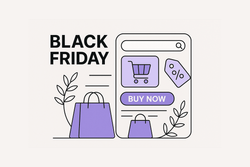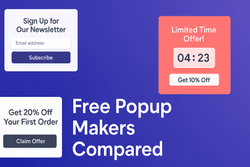
The 2025 Marketing Funnel, Without the Fluff: TOFU→MOFU→BOFU Widgets That Convert
Turn theory into screen‑level tactics. See exactly which conversion widgets to place on your blog, homepage, and pricing pages plus frequency rules, tracking events, and real TOFU/MOFU/BOFU funnel examples you can ship today with Onvocado.
- Written by Milla Leane |
- October 30, 2025
Foreword
Most posts on the marketing funnel stop at definitions. This one doesn’t. You’ll get screen‑level tactics, what to show, where to show it, and how often, so your TOFU→MOFU→BOFU plan turns into measurable sessions, events, and revenue. We’ll pair timeless funnel logic with 2025 realities: non‑linear journeys, consent and signal loss, and the rise of onsite conversion widgets you can deploy in minutes.
Along the way, you’ll see concrete examples you can implement with Onvocado components, plus frequency caps, form patterns, and tracking checklists that work whether you’re SaaS, ecommerce, or apps. Let’s build a funnel that respects users and compounding data, without the fluff.
TOFU→MOFU→BOFU in 2025 (and why journeys aren’t linear)
Journeys are non‑linear. Google and the Boston Consulting Group have both documented how people loop between discovery, evaluation, and moments of need across devices and channels. Yet the TOFU, MOFU, and BOFU shorthand still matters for searcher intent, internal planning, and analytics segmentation. In 2025, treat TOFU/MOFU/BOFU as modes a user can slip into at any moment, not fixed stages. Your job is to meet the mode with the right message and the lightest, most respectful conversion opportunity.
Think in terms of “screens, signals, and stakes.” A screen is the surface a user sees (blog post, homepage hero, pricing table). Signals are behaviors (scroll depth, source/medium, pages viewed). Stakes are the user’s perceived cost to engage (email share vs. booking time). TOFU screens get low‑stakes asks; BOFU screens earn higher‑stakes asks because intent is clearer. Onvocado helps translate this logic into deployable UI with flexible targeting, so your Onvocado components serve the right mode without manual page‑by‑page work.
Finally, embrace loops. Someone can arrive in BOFU mode on your pricing page, bounce to a blog (TOFU mode to self‑educate), then return via email (MOFU nurture) before converting. Google’s and BCG’s work both reinforce this pattern. Map content for each mode, but connect it with consistent tags, events, and offers so movement between modes is seamless and measurable.
What to show, where to show it: examples for blog, homepage, pricing
Blog (mostly TOFU, occasional MOFU)
Goal: earn attention and consent without disrupting reading. Use a slim sign‑up bar for newsletter/lead magnet and a polite slide‑in that appears after 45–60 seconds or 50% scroll. Offer a single clear value (e.g., “Weekly teardown + templates”). Keep the ask low‑stakes: email only. For high‑intent posts (e.g., competitor comparisons), add a contextual MOFU block that invites readers to view a demo video or case study rather than a hard CTA.
- Widgets: sign‑up bar, slide‑in card, content upgrade gate
- Good fit: sign‑up bar template, collect emails playbook
Homepage (mixed modes)
Goal: route by intent. Show a multi‑step quiz or segmented email capture to personalize follow‑ups. Use a small, persistent help CTA ("Talk to sales") for BOFU visitors, but don’t let it overshadow primary navigation. For returning users, promote product updates they missed.
- Widgets: multi‑step form, intent buttons, announcement bar
- Good fit: announce product updates
Pricing (mostly BOFU)
Goal: remove friction and de‑risk. Use a sticky comparison note (what’s included, most‑picked plan), a lightweight question widget that opens a short form for objections, and a limited‑time incentive only for returning, high‑intent users (cart‑like behavior). Avoid blanket discounts; instead offer a trial extension or onboarding session to protect brand equity.
- Widgets: micro‑FAQ, objection capture, limited‑offer flyout
- Good fit: coupon and offer widgets
Recommended popup/form patterns per stage + frequency rules
TOFU patterns: sign‑up bars, slide‑ins, and inline content upgrades. Keep fields minimal (email only). Delay appearance to after engagement (scroll or time) and use soft exits. Frequency: show once per session, then snooze 7–14 days on dismiss. Avoid full‑screen modals unless tied to a special campaign window.
MOFU patterns: multi‑step popups and segmented forms that discover use case, team size, or role. Ask one question per step and preview the value of sharing more data (e.g., tailored playbooks). Combine with subtle social proof. Frequency: limit to 1 exposure per user per week unless new content is released.
BOFU patterns: micro‑FAQ widgets, sticky assistance buttons, and small flyouts offering a consult, trial extension, or onboarding help. Keep copy specific to the page ("Questions about annual billing?"). Frequency: show only when pricing is in view or on return visits. Trigger exit‑intent sparingly, and never stack with other overlays.
- Pros: progressive profiling, better UX, higher consent rates
- Cons: over‑targeting can reduce perceived quality; respect cadence
Implementation tips: use a single orchestration layer for triggers and caps to prevent conflicts. If you’re new to multi‑step forms, start here: mastering multi‑step popups. For simple top‑of‑page collection, deploy a proven sign‑up bar template and A/B test the lead magnet promise.
Tracking the handoff: events to log and why
Non‑linear journeys break when data is siloed. Google and BCG both emphasize cross‑touchpoint measurement, so design your events to stitch modes together, not just pages. Start with a clean schema:
- content_view (article_id, category)
- content_engaged (scroll_50, time_60s)
- signup_started (surface: bar|slidein|modal, step: 1)
- email_submitted (source: blog|home|pricing, segment)
- demo_requested (plan_interest, objection)
- pricing_viewed (returning_user, plan_hovered)
- offer_redeemed (offer_id, eligibility)
- feedback_submitted (nps, csat, intent_to_churn)
Why these matter: you can attribute list growth to TOFU surfaces, prove MOFU segmentation improves BOFU conversion, and detect friction (e.g., lots of signup_started, few email_submitted). Pipe submissions to your ESP/CRM with server‑side tagging, then mirror key events for ad platforms to improve remarketing quality.
Connections to set up: sync captured emails and segments to your marketing stack. Start with Mailchimp or Klaviyo for nurture, and use the Zapier integration for custom CRMs or data warehouses. Keep PII handling explicit and provide one‑click unsubscribe and preference management to maintain trust.
Real widgets to move people forward (with pros & cons)
TOFU: Value‑first email capture. Use a content upgrade or newsletter bar with a single field and a crystal‑clear promise (“1 teardown + 1 template weekly”). Pros: low friction, compounding list growth. Cons: lower immediate revenue impact. Try gamified formats sparingly e.g., a controlled spin‑to‑win template only on promo periods and cap frequency.
MOFU: Segmentation and proof. Deploy a 2–3 step form that asks role/use case, then routes to tailored assets or onboarding flows. Complement with social proof blocks and mini‑case studies in‑line. Pros: better fit and messaging; higher demo quality. Cons: can depress completion if steps feel opaque. Use progress indicators and auto‑advance fields. See feedback surveys for post‑engagement signals that guide routing.
BOFU: Risk removal and urgency. Offer a modest incentive for returning visitors (trial extension, onboarding call) via a small flyout near pricing tables. Pair with a concise micro‑FAQ that answers billing, security, and migration. Pros: reduces anxiety, boosts CR. Cons: discounts can train wait‑for‑sale behavior-prefer value‑adds. For promotions, targeted coupon and offer widgets keep control on eligibility and duration.
Don’t forget lifecycle: announce meaningful releases to reactivate dormant users with a contextual banner linked to docs or a short video. The announce updates pattern keeps product momentum visible without hijacking the session.
Optimization cadence: tests, guardrails, and lift that lasts
Test what changes decisions, not what only changes clicks. Start with hypotheses tied to mode: TOFU tests = lead magnet promise and format; MOFU tests = segmentation questions and order; BOFU tests = objection handling and offer framing. Use holdouts for promo widgets to measure incrementality, not just raw conversions. A simple starting point: A/B a plain bar vs. a bar with a tiny visual in your top blog posts; see this A/B testing guide for setup fundamentals.
Guardrails: cap exposures across surfaces per session; suppress all overlays for users in high‑risk flows (checkout, payment, critical forms). Measure engagement debt dismiss rates, rage clicks, and scroll reversals to avoid trading long‑term trust for short‑term lifts. Research like why the marketing funnel is still relevant in 2025 underscores the value of structured stages; your UX should preserve that clarity.
For qualitative signal, run periodic, lightweight NPS/PMF prompts; tailor frequency by user tenure. This post on effective feedback widgets shows options that won’t derail sessions. Document learnings and roll winners into presets so your team ships faster next quarter.
Funnel examples by industry (and common pitfalls)
SaaS: TOFU: content upgrades attached to technical guides; MOFU: 2‑step use‑case quiz routing to tailored demos; BOFU: micro‑FAQ near pricing plus onboarding‑call offer for returning visitors. Pitfalls: pushing annual discounts too early; collecting firmographics without offering value.
Ecommerce: TOFU: email‑for‑guide or lookbook; MOFU: size/fit helper with email capture for back‑in‑stock; BOFU: limited‑time offer for returners who added to cart but didn’t purchase this week. Pitfalls: blanket popups on first page load; not segmenting for new vs. returning visitors.
Apps: TOFU: platform‑specific content and creator collabs; MOFU: feature quiz that maps users to the right plan; BOFU: trial extension or concierge setup. For a mobile‑first view, see this overview of the app marketing funnel in 2025. Pitfalls: relying only on paid UA without onsite consent collection.
Evaluator’s detour: some users research tools before converting. Provide honest comparisons to help them stay; for example, if you’re weighing onsite conversion platforms, see a neutral OptinMonster alternatives overview. Finally, close with a concrete path forward—templates and frequency rules—so visitors don’t stall in MOFU.
CTA: Ready to ship without reinventing the wheel? Try a prebuilt funnel pack in Onvocado—pricing is transparent and you can adapt templates fast on day one. Try a prebuilt funnel pack in Onvocado.
Share this article
About the author

Milla Leane
Milla is a content creator and is all about creating impactful, educational content for brands. She loves experimenting with new trends and strategies, always aiming to deliver real value instead of just churning out posts. For her, it’s about building genuine connections and ensuring every piece of content has a purpose.
Discussion
No comments yet. Be the first to comment!

